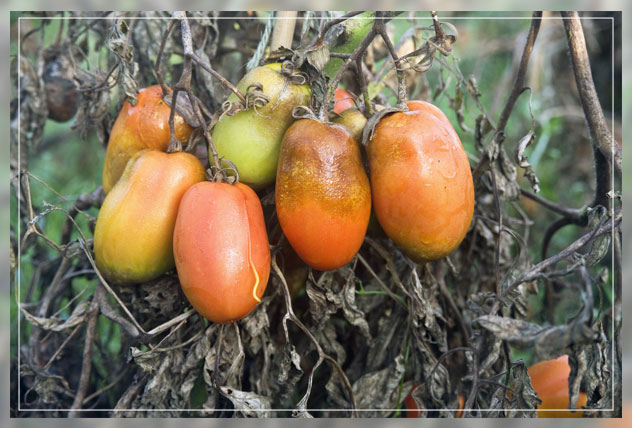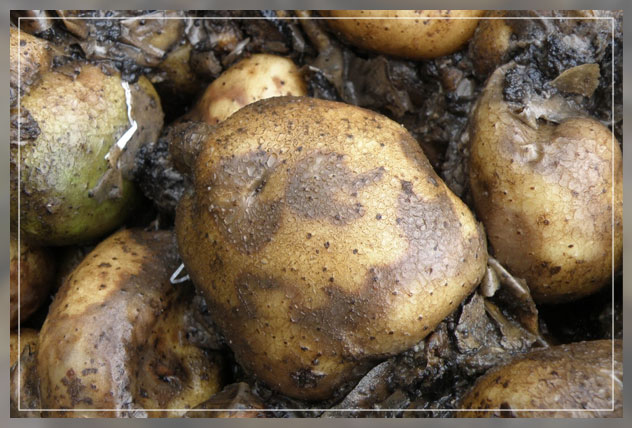There is no plant entirely immune from disease and pest infestation. One such serious plant affliction is late blight.
This is a disease caused by the pathogen Phytophthora infestans.
The pathogen tends to infect the flowering plants belonging to the Solanaceae family.
It can affect edible plants such as eggplant, pepper, also petunia and nightshades, however, it worst affects potatoes and tomatoes.
Potatoes and tomatoes develop large, greasy grey spots and soft rot.
Plants can die quickly but in this article, you will learn how to protect them in time to reduce losses.
Keep reading below to know more!

Symptoms of Late Blight
The fungus Phytophthora may affect your plants late in the season as the name suggests, but this affliction can also occur at any time of the year.
It spreads quite fastly, infesting your entire garden.
It destroys the fruits of the plant and the symptoms will occur all across the plant.
Firstly there will be a soggy appearance of the old leaves and stems of the plant.
The leaves of the potatoes plant will have necrotic, circular and brown lesions inside pale or chlorotic tissue.
Eventually, these white or dark spots will cover the entire plant.
The wet, oily, enlarged leaf lesions result in sporulation which you can see as white or gray fuzzy growth.
The stems with black, dark brown or dark green lesions will also have sporulation.
In potatoes, the lesions can also extend into the tuber.
The lesions appear different because of the moisture difference.

Since the fungus is carried by pores, it can travel far away, spreading the infection to your other plants.
Moreover, late blight can overwinter.
Even if there is a cold frost, it can still return next year.
So in order to remove it, you will have to remove the soil containing the pathogen.
Once you have identified late blight in your tomatoes and potatoes, contact a nearby cooperative extension service.
The infection may stem from another nearby source and contacting them soon can get rid of the infection that may be stemming from a plant in close proximity.
Naturally, after identifying the symptoms, it is time to treat and prevent the infection.
Let’s find out about that below!

Treatment of Late Blight
When you find out that your plants have already caught the late blight, it is time to act immediately.
Late blight can spread to many of your plants quickly, therefore, treat the plants to limit the spread in order to spare the remaining plants.
Head to the infected plant and carefully remove the stems, fruit and diseased leaves.
You should throw away these scraps.
Do not think of composting these as that will only spread the infection even more.
After removing all the damaged parts you can see, it is time to apply a fungicide to the plants instead.
That will prevent the infection from returning and spreading in the entire plant.
For the choice of fungicide, go for a copper-based fungicide with weekly applications.
This way you will be able to salvage the rest of the plants.
As you reach the end of the harvest, it is time to completely remove the plants.
Not only do you take away the plants but also the soil that surrounds it in your garden or any remaining scraps.
This way you can completely eradicate the infection from your plants and soil so that it does not affect the plants you will later deploy.
In order to assure that your next crops will grow healthy, you should start again using fresh seeds and soil in the next year.
Make your garden entirely late blight free!
Though, preventing it will be easier than eradicating it from your garden and treating your plants.
So how should you go about that?
Don’t worry we have you covered!

Prevention of Late Blight
In order to prevent it, begin by looking for varieties that are resistant to it.
For instance, when it comes to tomatoes, the Mountain Magic and Crimson Crush varieties are resistant to the disease.
Therefore, you start by reducing the possibility of disease in your crops.
This way you can save most of your plants planted in the same soil.
While planting your tomatoes, use cages or stakes where the tomato plates grow off the ground.
Moreover, choose a spot that does not receive much wind.
Both these measures will provide the plant protection from blight spores that are not present in your garden but have traveled a distance with the help of wind from nearby gardens.
If you doubt the blight has reached your plants but are not sure, then one way to eradicate it is to let it dry.
The fungus grows well in wet and humid environments.
Therefore begin watering the plants in the morning.
This way they will be able to dry out in the sun rather quickly.
There is a lesser chance of thriving in dry conditions than in wet ones that will rather support its spread.
In order to manage late blight, you should focus on:
- limiting initial inoculum: this is the first wave of spores or sporangia
- preventing the spread of secondary inoculum: this is what happens later, the waves of spores that are now produced on the plants)
Management is a mix of prevention and treatment.
You should firstly only plant healthy seed potato tubers and tomato plants, also destroy the waste and cull potato tubers.
It is better to plant resistant cultivars to reduce the chances of disease.
Anything that is grown from previous years’ planting should no longer be here.
So destroy and remove the unwanted tomatoes and potato plants that grew from last year’s plantation.
You also do not want unmanaged but infected plants in your garden.
Remove all of these from your garden.
Next up, while plantation, space rows so that there is less moisture and increased airflow.
Lastly, do not leave an option for the fungus to attack your plants and apply a fungicide beforehand, preventing the chances of infection.

Saving Food to Consume
Can you eat the potatoes and tomatoes that have been infected by late blight?
Yes, you can!
They are usually safe to eat as the fungus does not affect humans.
However, they still need to be in a good enough condition tp be eaten so it depends on when you are able to save the potatoes and tomatoes.
For instance, if there are some blight lesions, all you need to do is to cut those parts off.
If the rest of the potato and tomato is still edible, you can use them as normal.
So in this way, the plants are still usable and you can utilize them for your daily use as the produce from your kitchen garden.
Unfortunately mostly, the blight will infect the plants even before they have been able to ripen fully.
Hence, the plant does not progress fully when it is unable to ripen.
So in that case, there is a greater chance that the plant will rot instead of ripening further.
That renders it useless and you will not be able to consume it.
It is thus, important to save the plants by preventing the chances of late blight infection.
If the plant is infected, you may still have a chance at saving the seed and using it.
That is the case for tomatoes, at least.

Saving Seed
Generally, tomato diseases will last from year to year.
That is not the case with late blight because it requires living tissue in order to sustain.
Hence, you can dry, save and use the seeds of infected tomatoes.
The late blight in them may not affect your plants in the next growing season.
However, it may still be a better option to clear away and thoroughly dispose of the leftover fruits and all the affected foliage at fall time.
Plus, it’s wiser to plant the tomatoes in a different section altogether.
The same is not the case with potatoes, they are still alive when stored.
They could continue having the disease.
Thus, there is no point in leaving any potatoes that could potentially carry the disease in the winter.
Rather start all over with fresh seed potatoes in the spring.
When it comes to preservation, you should choose the fresh and healthiest tomatoes for canning as well.
Because even if there is no living tissue, it can raise the pH of the acidic tomatoes.
The surge in the pH allows for bacteria and spoilers to start growing inside.
Hence, it affects the flavor but most importantly the safety of canned tomatoes.
So you do not want to take the risk and use only healthy produce.
Finally,
Saving and preserving food with late blight is tough.
The best option is to still plant resistant varieties to prevent the onset of this infection.
If the disease has still spread from neighboring gardens, take immediate action in saving all of your plants.
The infection spreads rapidly so its cure should also be fast enough to contain it.






Leave a Reply